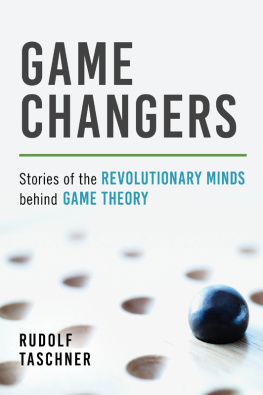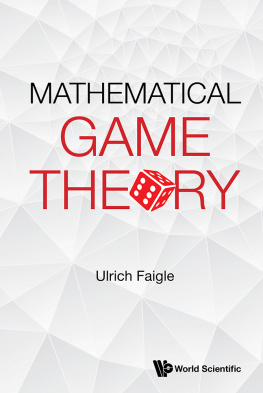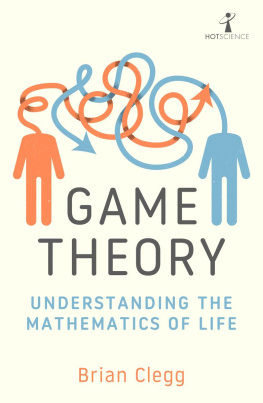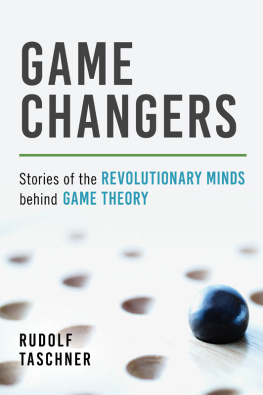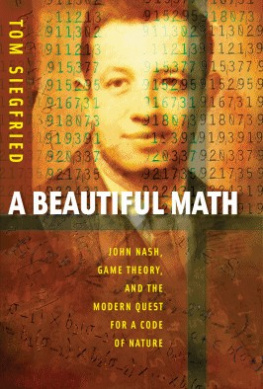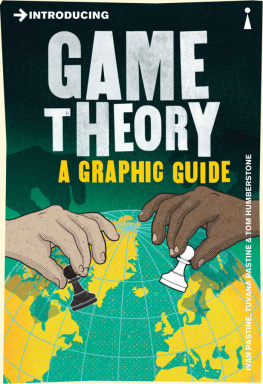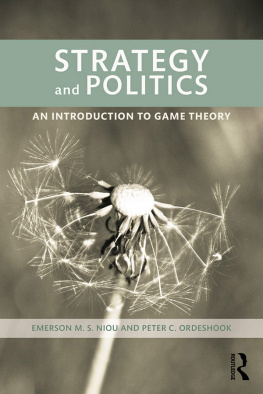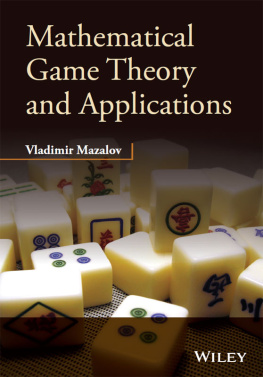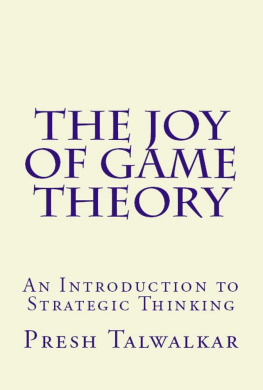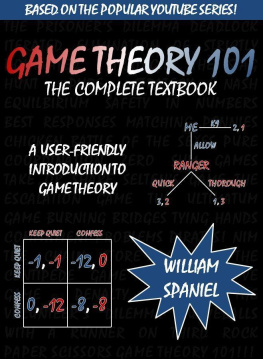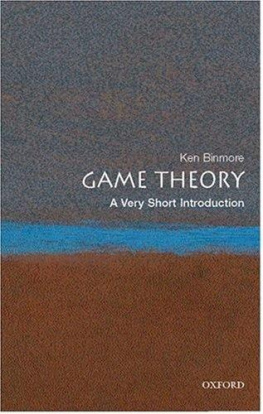
VIENNA, 2017
The idea for this book was conceived in one of Vienna's beautiful coffeehouses, and my wife, Bianca, managed to use her irresistible enthusiasm and conviction to persuade first Christian Koth from the Hanser publishing house and then me that game theory was indeed a subject worth writing about, particularly when it is not forced into a mathematical corset but is instead addressed in a broader context. I would like to thank Mr. Koth and the considerate, generous people at Hanser for the trust they placed in me. An author could not wish for a better publishing team.
I am delighted that, thanks to the initiative of my friend and colleague, the outstanding mathematics teacher Alfred Posamentier, the renowned publishing house Prometheus decided to make the book available to an American audience. I am extremely grateful to Alfred Posamentier, as well as to Steven Mitchell and his excellent team at Prometheus, for making this possible, and I must also thank the book's translator Brian Taylor, whose experience, care, and accuracy are matched by his feel for both German and English.
I owe particular gratitude to two mathematical colleagues and friends for helping me get to know more about game theory. The first is Alexander Mehlmann, who works at math.space, the project organized by my wife in Vienna's Museumsquartier and sponsored by the Austrian government, and which allows the wider public to be exposed to mathematics as a cultural achievement. In his profound yet witty lectures, Mehlmann looks with great circumspection at mathematical game theory, the specialist field he has made his own, inspiring enthusiasm for the subject among laymen and professional mathematicians alike, including myself. The second person I must thank here is Karl Sigmund, the doyen of the Faculty of Mathematics at the University of Vienna, one of the great mathematical luminaries of our time, not merely an unerring expert on probability and game theory, but also an outstanding authority on mathematical history of the last century, whose exhibitions held in numerous venues and whose books about Kurt Gdel and the Vienna Circle have set new standards.
Above all, I am grateful to Karl Sigmund for having cast a critical eye over the majority of my manuscript, thus helping me to eliminate manyall, I hopeembarrassing mistakes I had made while writing the book. In addition to this, I was also able to enlist the help of one of Austria's top science journalists, Thomas Kramar from the daily newspaper Die Presse, to read through the entire manuscript. The advice given by Sigmund and Kramar was of particular value, since I decided in this book to have my heroes appear in scenes and use direct speech. Since it is a Sisyphean task to present history as it actually was, I thought it might be more amusing and perhaps even more instructive for readers if the historical facts were transformed into fictional, dramatized accounts. The use of the present tense in these lively scenes enables the reader to recognize the shift from the more matter-of-fact reports about events. Meir Shalev once said that the stories that we tell are more precise than reality, and I completely agree. In this respect, everything that is described in the book is believable and true for the very reason that I made it all up
I hope that people will gain as much enjoyment from reading the book as I did from writing it. I owe the blessed position that I was in above all to my wife and to my children, Laura and Alexander, all of whom offered constant help and encouragement during every stage of the book's development.
EXERCISES
1. Mziriac's think-of-a-number game
In his book Problmes plaisants et dlectables qui se font par les nombres, published in the seventeenth century, Bachet de Mziriac presents the following game: Two players sit opposite one another. The first person names a number between 1 and 10. Then the second person thinks of a number between 1 and 10, adds it to the one just named and calls out the total. The first person then adds, in his turn, a number between 1 and 10 and calls out the new total. The two players alternate in this way until one of them is able to call out a number greater than 100. The one who can say a number greater than 100 has won the game.
Question: How does a conman proceed when he takes his opponent to the cleaner's in this game?
A) He tries to name one of the numbers 10, 20, 30, 40, 50, 60, 70, 80, or 90. As soon as he manages this, he proceeds in multiples of ten.
B) He tries to name one of the numbers 2, 13, 24, 35, 46, 57, 68, 79, or 90. As soon as he manages this, he proceeds in multiples of eleven.
C) He keeps naming a number that is 1 more than his opponent's, until his opponent names a number between 80 and 89. Then he responds with 90 and, because his opponent can only say a number between 91 and 100, the conman has won.
2. A force-majeure exercise
Two people playing a game of chance, in which the chances of each player winning a round are exactly fifty-fifty, agree that the first person to win five rounds will receive the entire stake. After the first player has won three rounds and the second player has won one, the game is interrupted by a force majeure, a superior force.
Question: Based on the rounds played so far, how should the stake be fairly divided up after the game has been interrupted?
A) The stake should be divided up at a ratio of 3:1 in favor of the first player.
B) The stake should be divided up at a ratio of 4:2 (i.e., 2:1), in favor of the first player.
C) The stake should be divided up at a ratio of 13:3 in favor of the first player.
3. A simple game of craps
Two dice are thrown. Beforehand, a player wagers a hundred dollars that the sum of the numbers thrown will be either seven or eleven. If he wins, he receives 300 dollars on top of his stake; if he loses, his stake goes to the gambling house.
Question: What winnings can the gambling house expect after 7,200 such games?
A) The house can expect a profit of about 80,000 dollars (before tax).
B) The house can expect a profit of about 40,000 dollars (before tax).
C) The house cannot expect any profit.
4. The Chevalier de Mr's mistake
The avid gambler Antoine Gombaud, known as the Chevalier de Mr, is said to have come to the following erroneous conclusion: he thought that, when throwing three dice, there was an equal probability of throwing a sum of eleven or a sum of twelve, since the sum of eleven could only be achieved by 1 + 4 + 6 = 1 + 5 + 5 = 2 + 3 + 6 = 2 + 4 + 5 = 3 + 3 + 5 = 3 + 4 + 4 and the sum of twelve could only be achieved by 1 + 5 + 6 = 2 + 4 + 6 = 2 + 5 + 5 = 3 + 3 + 6 = 3 + 4 + 5 = 4 + 4 + 4. That makes six different groups of numbers to get each of eleven and twelve, and, consequently, de Mr's view was that there is an equal probability of throwing a sum of eleven or twelve.
Question: How does this error arise, and which of the two total sums is more probable?
A) The Chevalier de Mr wasn't wrong at all, since the two sums are indeed equally probable.
B) The Chevalier de Mr overlooked the fact that, in the case of the total sum of eleven, three of the possible groups of numbers contain 2 identical summands, whereas in the case of the total sum of twelve, only two of the possible groups of numbers contain 2 identical summands, but another one of the possible groups of numbers is made up of 3 identical summands. The total sum of twelve is more probable than the total sum of eleven.

